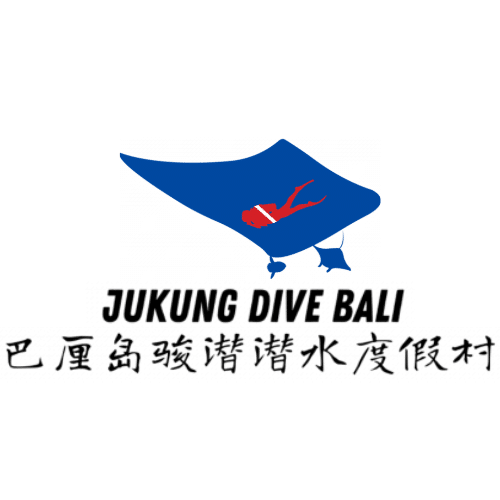EXPLORE ALL OUR BALI DIVE SITES
DIVE AROUND AMED & TULAMBEN
Besides the famous Liberty USAT Wreck, Amed/Tulamben is a paradise for macro lovers . Diving over black sand makes it all the more special and creates a contrasting, interesting backdrop for photographers.
Most of Dive centers in Tulamben won’t come to dive at Amed, but we cover all dive sites both in Amed and Tulamben. Below are some of the most well-known dive sites in both areas, but our expert local dive guides know much more secret dive sites for expert underwater photographers, make your menus of creatures that you want to see, our guide can find for you!
US Liberty Wreck
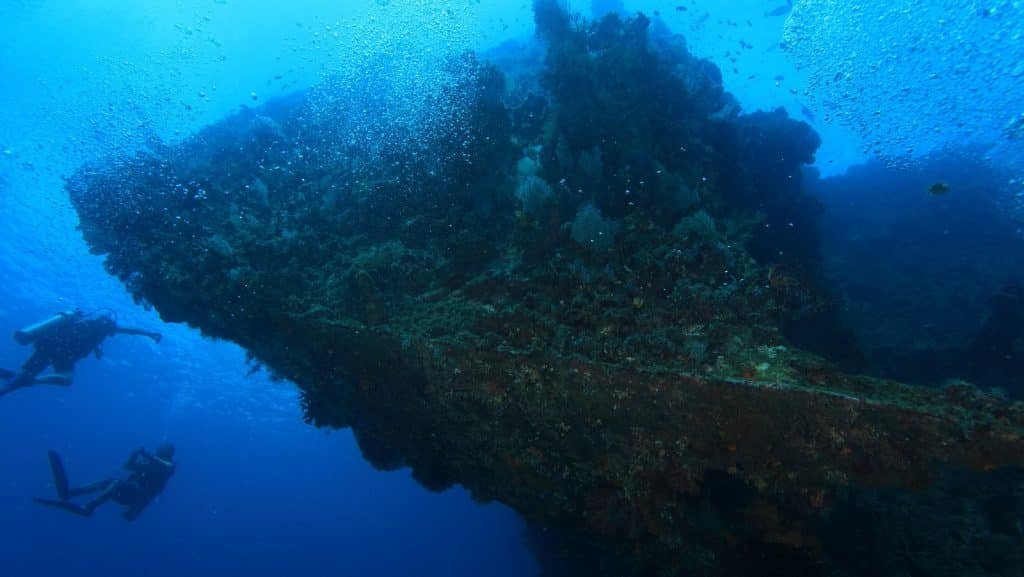
Depth: 3-30m
Difficulty: Easy
A historic artifact revitalized into one of the richest marine environments in the world. Only 25 meters from the shore, the Liberty is one of the most accessible wreck dives and Bali’s most famous scuba diving and snorkeling site.
The wreck is 120m long and it sunk off the coast of Tulamben in 1963. This is an easy dive site accessible by shore, but at the same time very interesting and home to amazing creatures. Anemones, soft and hard corals are grown all over the wreck.
For more photos can visite https://www.padi.com/dive-site/indonesia/usat-liberty-shipwreck/
(The USAT Liberty was a United States army cargo ship built in 1918. The ship served during both WWI and WWII. In 1942, the ship met the end of its sailing days when it was torpedoed by a Japanese submarine in the Lombok Strait. The damaged ship was towed to Bali, where it was stranded on the shores of Tulamben.
The boat remained here until the 1963 eruption of Bali’s Mt. Agung volcano. The tremors from the eruption forced the ship off the beach, sinking it under the water.
The 120 meter long ship now lays on its side, just 25 meters off the rocky shore. Over the years, the Liberty has transformed from a barren heap of wreckage into an ecosystem teaming with life. The ship itself is covered in soft and hard corals, gorgonian fans, sponges, sea anemones, and crinoids, providing the perfect sanctuary for all different kinds of marine wildlife.
Because it sunk right offshore, divers are able to enter the water directly from the beach. The shallowest part of the ship is only 3 meters below the surface and the deepest is about 30 meters down. This makes the Liberty a great wreck dive for all levels of scuba divers, even beginners.
Marine Wildlife
The Liberty Wreck is an underwater wonderland that is home to a wide array of marine wildlife. A huge school of bigeye trevally (or jackfish) is often seen swirling around the wreck, while reef fish like sweetlips, angelfish, batfish and surgeonfish find refuge in and among the ship’s nooks and crannies. Turtles, napoleon wrasses and great barracudas are also common visitors to the wreck. On the way back to the shore, you can spot a group of garden eels poking out from the sandy seabed and swaying in the current. It’s also a perfect spot for night dives, before COVID, there were a resident school of bumphead parrotfish that made the wreck their sleeping quarters, unfortunately they were gone now.... But still a lot to see during night dive and sunrise dive there. )
Coral Garden
Drop Off
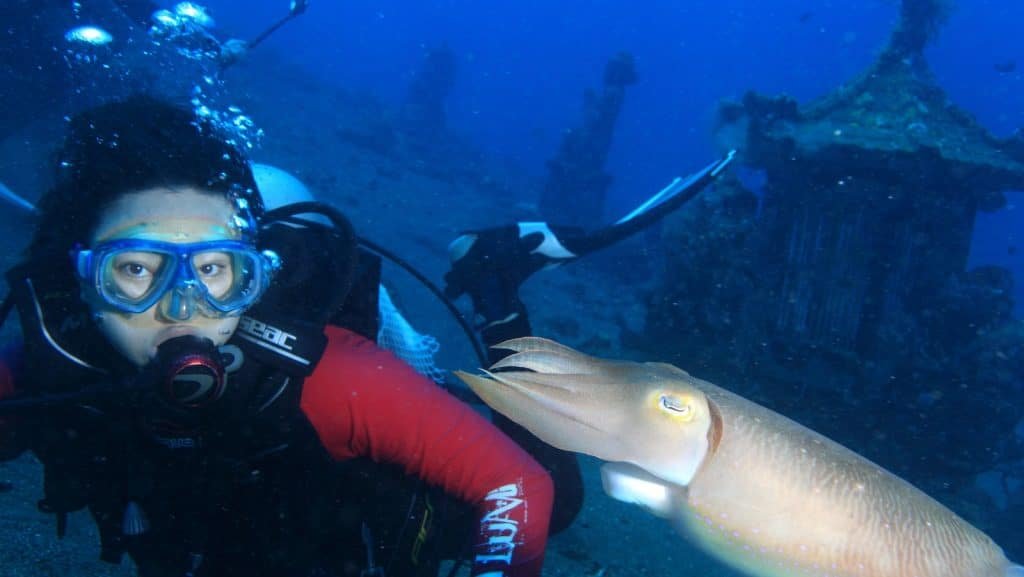
Depth: 3-30m
Difficulty: All level
The Coral Garden, located between the Liberty Wreck and Drop-Off dive sites, is a shallow reef abounding with colorful corals and rare marine life. This easily accessible reef stretches for about 150 meters along the shore of Tulamben Bay.
One of the unique features of this site are the sunken Balinese statues that are scattered around the area, including figures of Buddha and various Hindu gods. These artistic structures serve as an artificial reef, attracting a variety of marine life.
Because of it’s shallow depth, the Coral Garden is an excellent location for beginner divers to practice their skills, as well as a rewarding site for snorkeling. Underwater photographers also frequent this site due to it’s clear waters and abundance of macro life.
The “Drop Off”, also known as the TULAMBEN WALL, is a nice and deep wall absolutely amazing for any type of diver. Starting from a depth of only 3 meters, the wall reaches a max depth of over 80 meters! Covered in corals, the wall is home to many different type of marine life. Its’ dramatic natural feature was formed by the lava flow from the eruption of Mount Agung in 1963.
The Drop Off is great site for divers of all levels to explore. The depth of the dive can be adapted based on your experience.

Kubu
Boga Wreck
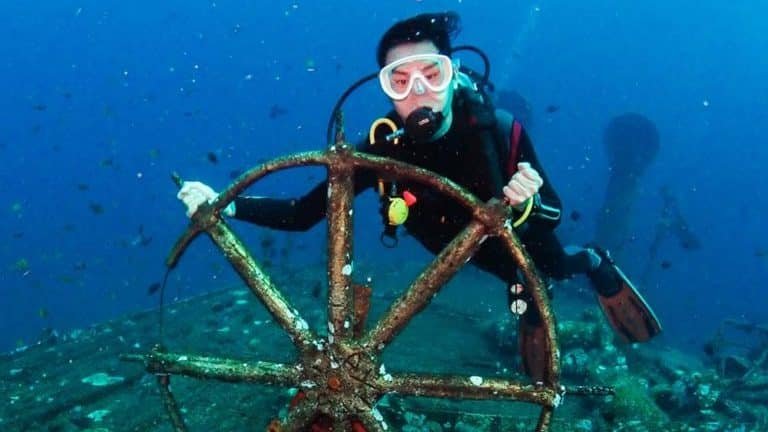
Depth: 18-40m
Difficulty: Advanced
Bali’s newest shipwreck remains nearly fully intact as it transforms into a haven for marine life. The site also features a submerged VW car and other interesting pieces.
The Boga Wreck is located just off the coast of Kubu, a village just north of Tulamben. Due to its location, you may also hear this dive site referred to as the “Kubu Wreck.”
In its former life, the Boga ship was a patrol vessel used by the Indonesian Government. In 2012, the ship was intentionally sunk to create an artificial reef for marine life and an intriguing new dive site. The Boga Wreck now rests on a sandy slope about 60 meters off the beach, spanning nearly 45 meters in length. Though not as massive as the Liberty, the Boga has its own allure that makes it worth exploring.
One of the main differences that you’ll notice between the two shipwrecks is that the Boga Wreck is still mostly intact. It’s easy to make out the different parts of the vessel which lies with its bow facing the shore and its propeller extending down into the sea. Some of the interesting features that divers will see include a wooden steering wheel on the ship’s upper deck, as well as buddha statues and a Volkswagen car inside.
Because it is located between 18 to 40 meters deep, the Boga Wreck is only recommended for advanced scuba divers. It does, however, make an ideal location for deep training dives.
Seraya Secret
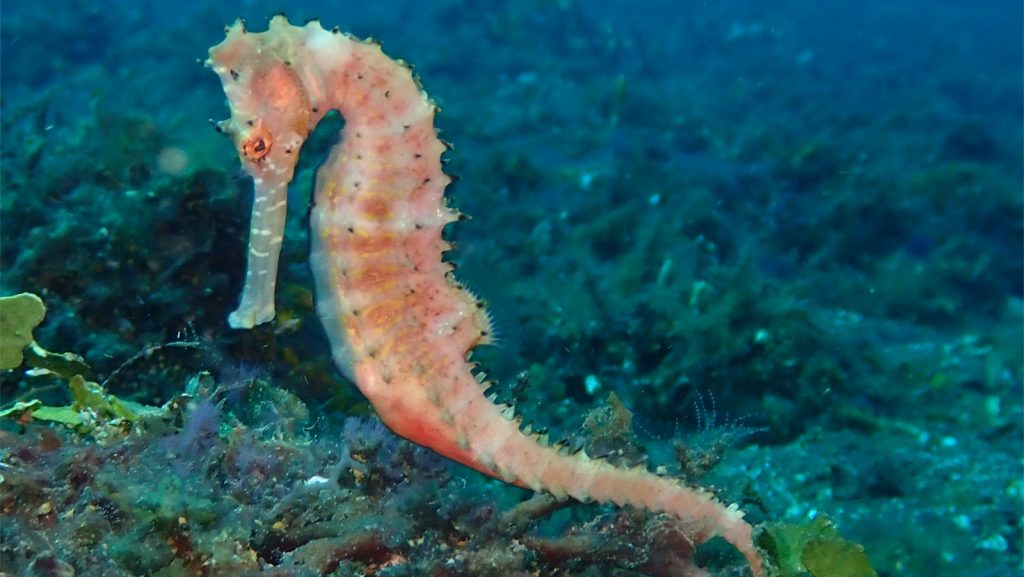
Depth: 3-35m
Difficulty: Advanced
A paradise for macro lovers and underwater photographers, this “muck diving” site is teeming with fascinating and rare little critters, including countless Nudibranch and the elusive Harlequin shrimp.
At first glance, it may appear that there is not much to see on this stretch of black sandy sea floor aside from a few small pebbles, rocks, and pieces of coral – but look closely and you’ll be in for a treat! Seraya Secrets is one of the best “muck diving” sites in Bali and an excellent spot for macro photography. True to its name, this dive site is chock full of marine secrets and the sandy slope is teeming with many tiny, yet rare, critters. Just make sure not to forget your camera!
Seraya Secrets is actually made up of three smaller dive sites: Top Secrets, Deep Secrets and Noisy Secrets, the latter of which gets its name due to the sounds made by the juvenile triggerfish that live here.
It is important to note that because this dive site has such a silty bottom, scuba divers should have good buoyancy skills and be able to maintain control to avoid stirring up the sand.
Be sure to come back again at night to uncover even more secrets and types of wildlife!
Alamanda
Batu Kelebit
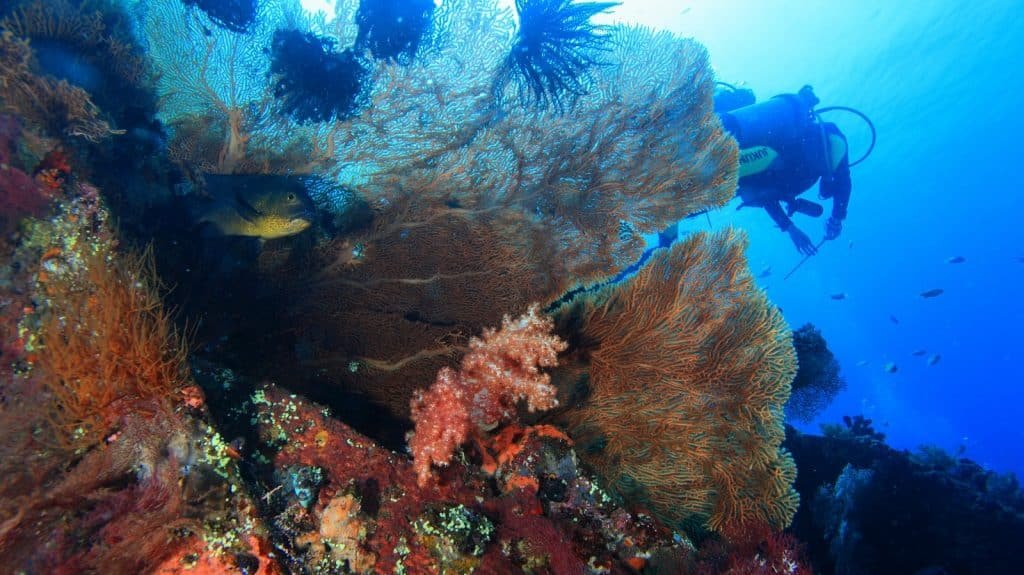
Depth: 8-30m
Difficulty: Intermediate
Two dive sites that will be done with jukung boats out of the bay where we follow a rocky slope with many species of reef fish.
Batu Kelebit are two large underwater rocks. The dive site consists of three steep ridges which are completely covered with hard corals, beautiful fire corals and sponges. Among these ridges is, in difference to the Tulamben area, white sand. The water temperatures are colder compared to Tulamben and the diving goes a bit deeper. The current sometimes can be strong but the ridges offer protection.
The next distinction you'll see is the underwater life. These two sites offer a bit of everything, the steepness of the ridges and their structure in combination with the plankton in the water nearly guarantee sightings of big fish like sharks, Napoleons, eagle rays, tuna, barracuda ..... On rare occasions, even thresher and hammerhead sharks, and whale sharks have all been spotted here!
Emerald
Palung Palung
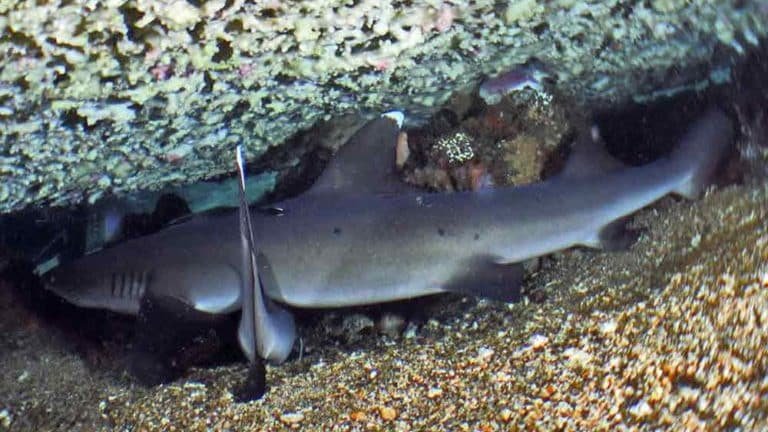
Depth: 3-30m
Difficulty: Intermediate
Two dive sites that will be done with jukung boats out of the bay, both remains mostly untouched.
Emerald, located just past Batu Kelebit,is a sloping reef canvassed with corals, gorgonians, and sponges. You’ll begin your dive at around 12 meters deep and can continue down alongside the slope until 30 meters or so, depending on your experience level. You’ll head back along the top of the reef in the shallower water. While the water is calm at first, be aware that there can sometimes be a stronger current that kicks in and turns the dive into a drift dive.
In Indonesian, the word “palung” means trough. The dives site gets its name because it begins where the sandy sea floor forms a gully, or trough-like shape. Proceeding over the side of this gully, divers will find a gradual slope that boasts an astounding variety of corals. From boldly patterned brain and honeycomb corals to rose-colored branching corals to dome-like mushroom corals, each patch of the reef offers something a little different. Purple tube sponges protrude from fields of briar corals and you’ll often see blue sea stars or their plump, granulated brethren clinging to the reef.
Because both dive sites are less trafficked, the hard corals and sponges that dominate the reef are larger and more pristine, and are good place to spot reef sharks and turtles under a table coral or patrolling around.
Jemeluk Bay
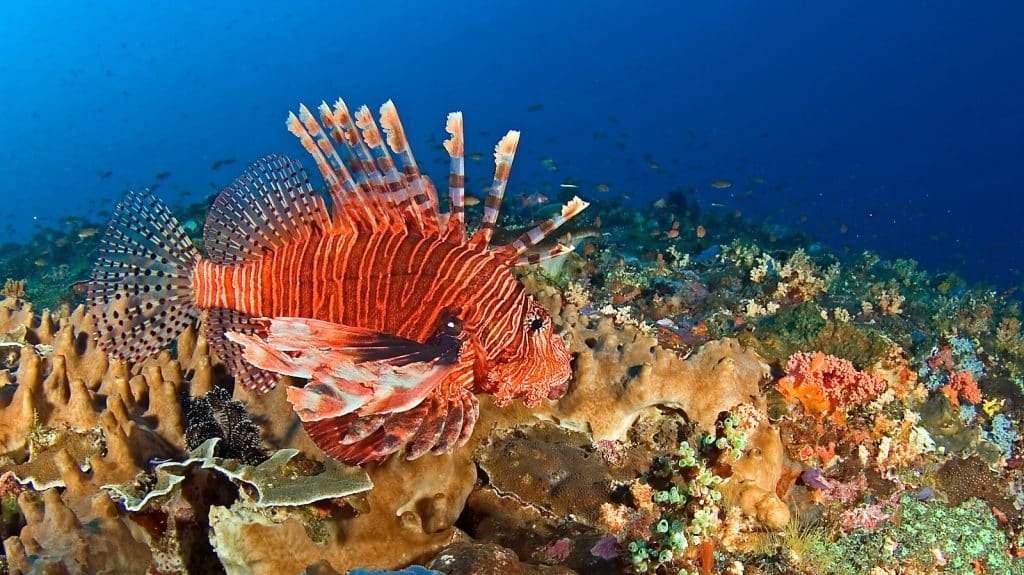
Depth 5-30m
Difficulty: All levels
Jemeluk bay is our ‘house reef’, easily accessed from the beach or by ‘Jukung’. Leaving from a sandy bay, the reef soon turns into a dramatic, sheer wall leading to about 40 metres which is covered in beautiful hard and soft corals. There is an abundance of marine life on this site, including many different kinds of nudibranch and leaf scorpion fish. You can often find sea horses in the shallow, sandy parts of the bay, watch trevallies hunt or simply enjoy the wall of corals as the current takes you back to your entry point.
The west side of the bay is ideal for introductory dives and open water diver course. The shallow sandy water at the start is ideal to become familiar with scuba equipment and the very gentle slope allows new divers to try out their new skills in a safe environment. It is a very easy dive site in Amed, perfect for underwater macro photography with the rare ghost pipefish and mimic octopus!
Pyramids
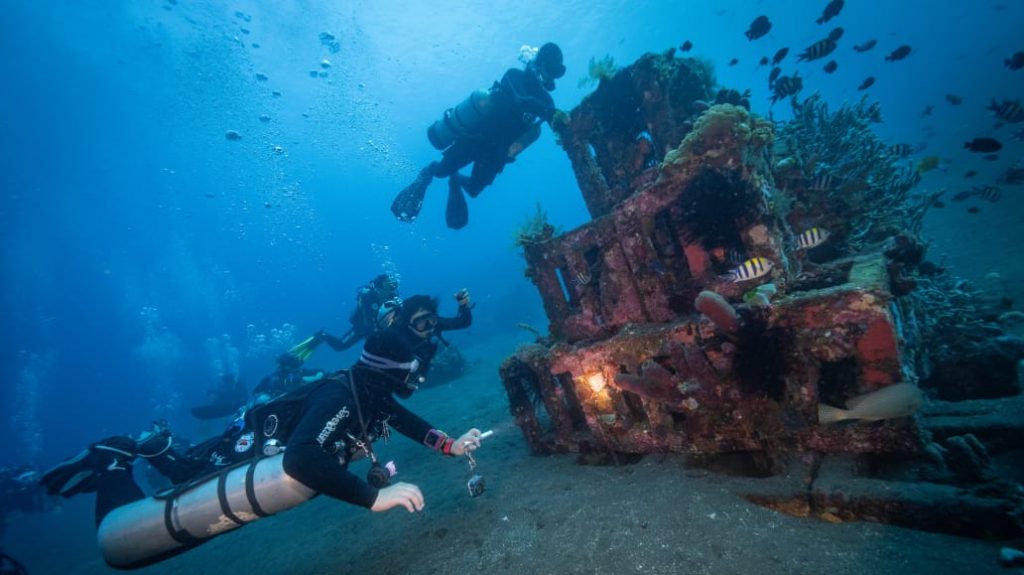
Depth: 5-30m
Difficulty: All levels
Pyramids, located right cross the road from the dive centre, is easily accessed from the beach. The Pyramids are artificially created reef structures, located in approximately 20+ metres of water, which have become home to a large variety of marine life.
This is the place to see pygmy seahorses hide in gorgonian fans, discover frogfish sitting on hard coral or simply enjoy a fast drift taking you along the reef. You may also spot hawksbill turtles here and the wall makes for a fantastic night dive.
Bunutan
Amed wall
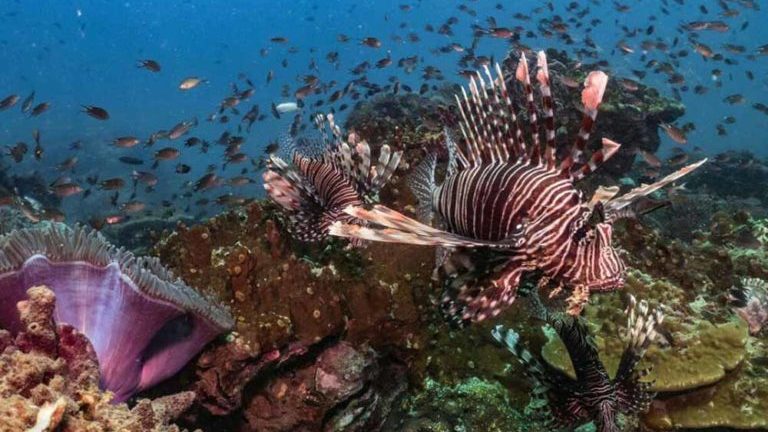
Depth: 5-40m
Difficulty: Intermediate
The jukung boat brings us to the starting point. Bunutan is a fantastic fast drift dive along a rich coral reef. Setting out from a large eel garden (sneaking up to these eels requires a bit of stealth and skill), you will pass big barrel sponges and giant gorgonian fans, before spending the rest of your dive exploring the beautiful coral garden here.An extraordinary dive for which some experience is needed.
Amed Wall is an impressive vertical wall with a maximum depth of 40meters. The wall is covered with beautiful hard and soft corals as well as sponges and sea fans. The underwater world is rich with lionfish, pufferfish, angelfish, triggerfish and many, many more.
Youfinish your dive over a shallow plateau bathed in soft sunlight. From overhead, the shadow of the jukung awaits your bubbles…already, it’s time to surface.

Japanese Shipwreck
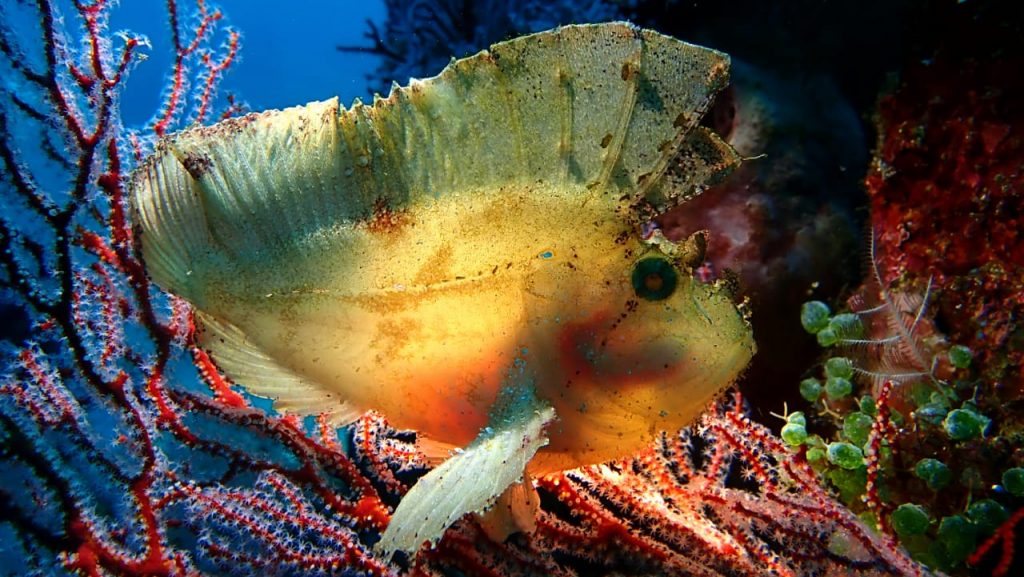
Depth 5-30m
Difficulty: Intermediate
We do 2 dives here, one on the right and one on the left. Shore dive where you can admire the unspoiled hard and soft corals, the many colors and the small wreck itself which is a breeding ground for fish. The Japanese shipwreck lies in shallow water (6 m). Behind the wreck the “real” dive starts and brings you along a slope with barrel sponges, hard corals, hiding moray eels and many other species. This is a photographer’s paradise with fantastic macro opportunities, pygmy seahorse, leaf fish, frog fish, nudibranch, you name them…. Be careful: The wall reaches approximately 35 metres and you may find strong currents on this site, and sometimes water temperature can drop to 24-25 degree in some part of the dive.
Gili Selang
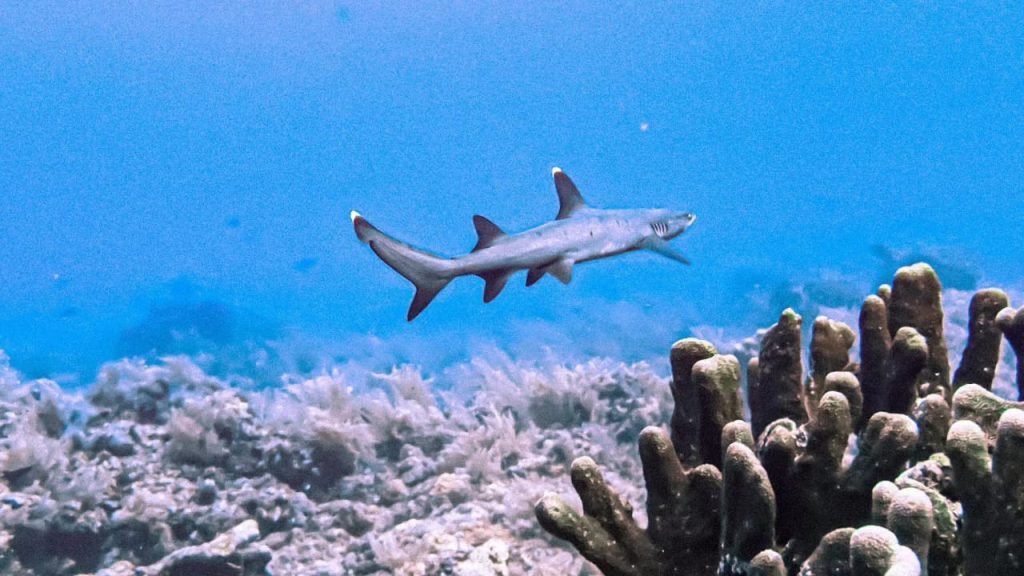
Depth: 5-35m
Difficulty: Advanced
Gili Selang is the most easterly point of Bali and sits on the very edge of the Lombok Strait. The more exposed areas can have up, down and swirling currents. We recommend being certified in drift diving for this dive site with loads of experience in varying currents. Considerable care needs to be exercised in the area. That’s why this site should be restricted to only very experienced divers. Please stay close to your dive master who understands the environment and currents best.
The site itself is a fairly steep slope covered with small rounded volcanic rocks and boulders. You’ll find some of Bali’s healthiest coral, turtles, bump head parrotfish, giant trevally, whitetip reefs sharks here. And, if you are lucky you may encounter hammerhead sharks or Mola mola.
The North Side of Gili Selang - Spectacular Drift Diving
On the North of the island, an interesting and rich sand slope has some stands of hard branching corals and occasional bommies. The deeper areas of the slope are more protected and therefore home to sea fans, soft corals, barrel sponges and coral bushes. As you follow the reef downwards, the sand slope becomes a wall and there starts the tricky current. Be careful here as it may carry you out of the bay.
On the South of the Island, the reef (Waterloo) becomes steeper but is far calmer, provided you do not sweep towards east. The coral growth in this area is very rich in both hard and soft coral with big Boomies and some huge Acropora table coral. This is a good place for macro photography.
Melasti Amed
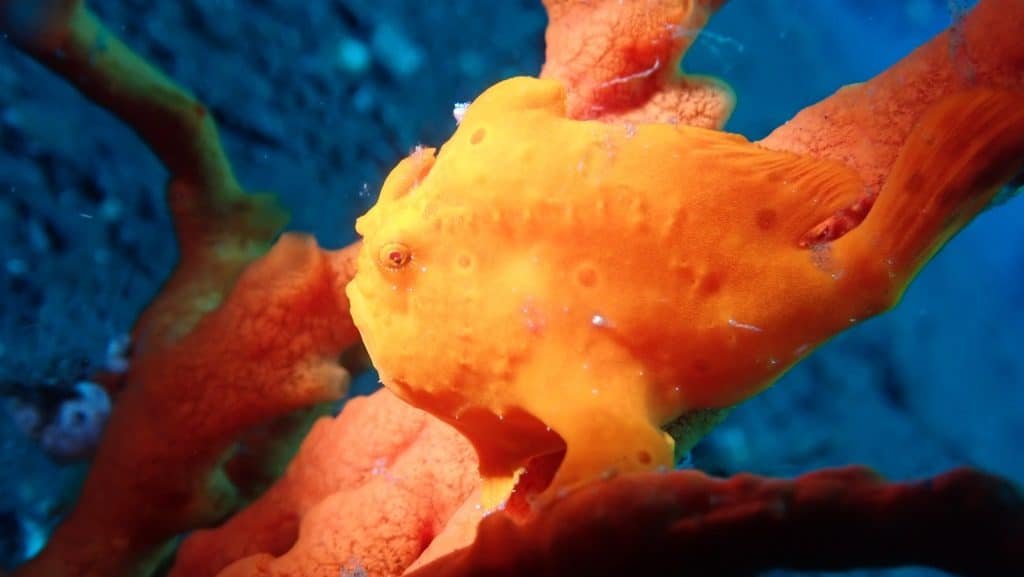
Depth: 3-35m
Difficulty: Advanced
Melasti Amed is a relative new dive site, it’s almost the Amed version of Seraya secret, another paradise for macro lovers and underwater photographers, this “muck diving” site is teeming with fascinating and rare little critters, including countless Nudibranch and the elusive Harlequin shrimp.
DIVE AROUND PENIDA & PADANG BAI
Nusa Penida is the only region in Bali where you can regularly see Manta Rays all year round and Oceanic Sunfish (Mola) – mainly between July and October. Penida is also home to over 500 species of reef fish, corals, and pelagic creatures.
Diving around Nusa Penida is fantastic all year round. During the rainy season the rains primarily happen in the late afternoon and evening, making diving very feasible, and sites are less busy. The ocean temperature during this time is warm and comfortable.
The marine life is consistently spectacular. During the peak season between June – November the water is much cooler, crisp and visibility is fantastic.
During this time you will have a high chance of seeing a Mola/Oceanic Sunfish/Moonfish. Our local manta population is here for 11 of 12 months of the year and the reefs are healthy and colourful 365 days of the year.
Padang Bai dive sites are almost the same distance as to Manta Point, when weather and sea conditions permit, we cover also dives sites in Padang Bai, which offer both macro and big creatures.
MANTA POINT
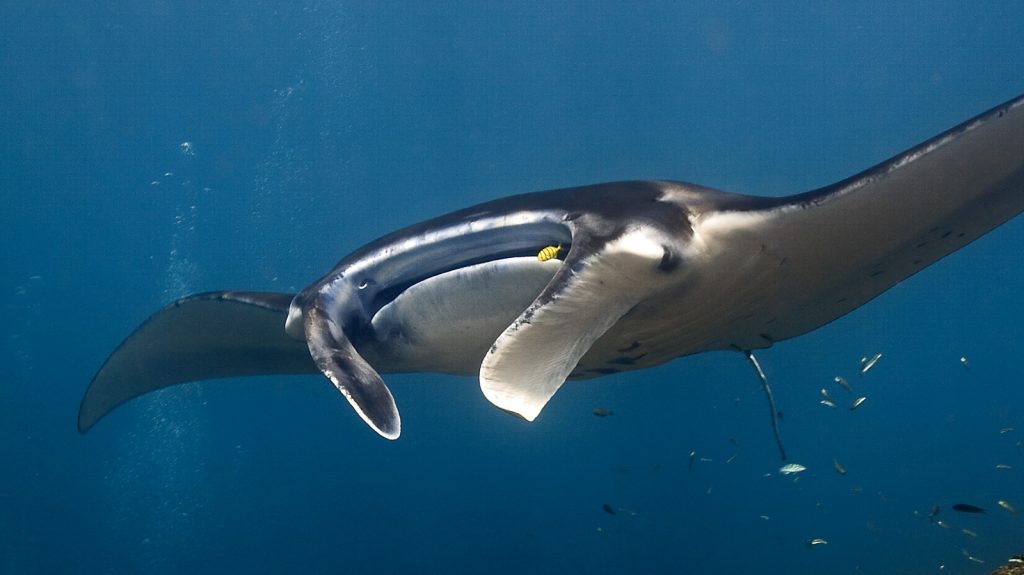
Depth: 5-30m
Difficulty: Advanced
As its name suggests, Manta point is the perfect place to swim with the mantas. No need to get very deep to see them because they usually stay around 3 to 10 meters, sometimes less. You have a higher chance to see bigger mantas than in Manta bay. Swimming slowly around, mantas come here for a cleaning session so it’s pretty common for divers to see them having their washing time.
Chances to see Mantas here are almost 300 days in one year! Seeing manta rays glide gracefully through the waters is really an amazing experience that you will never forget! One of the best manta ray diving sites in Indonesia!
Look out also for loads of blue spotted rays on the sandy bottom and unusually at this dive site they can be found lying on top of each other! Divers also find octopus on the huge limestone rocks that are a feature of this dive site as well as bamboo sharks or a chance sighting of Mola Mola.
Crystal Bay
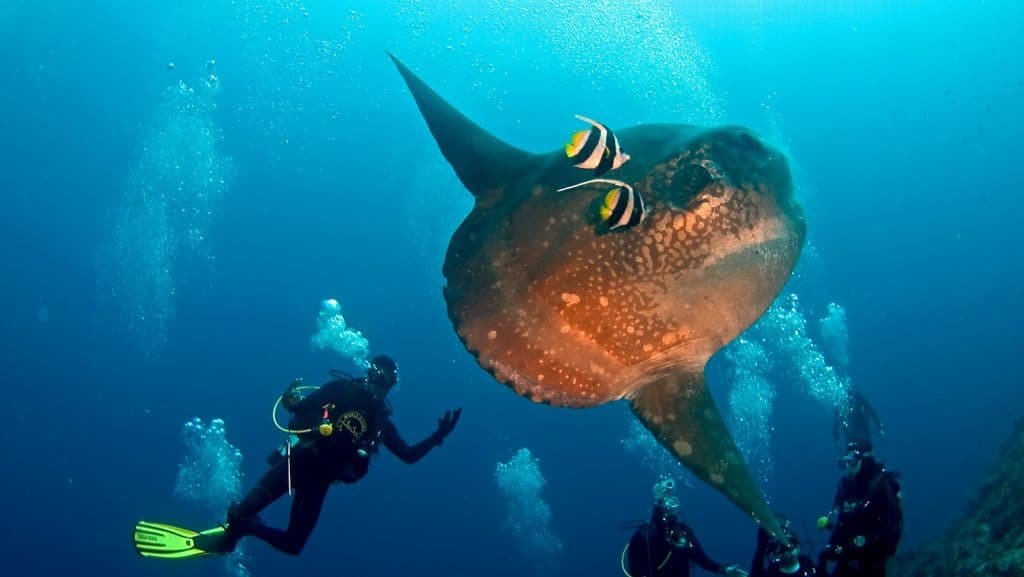
Depth: 5-40m
Difficulty: Advanced
Located in a gorgeous bay fringed by a white sand beach, Crystal Bay is definitely one of the most famous dive sites in Bali for its regular mola-mola sightings during the season (End of August to beginnning of November). Drop down to the sandy bottom and then head over pristine soft corals towards the corner where larger fish and Mola Mola are found in season.
MANTA BAY
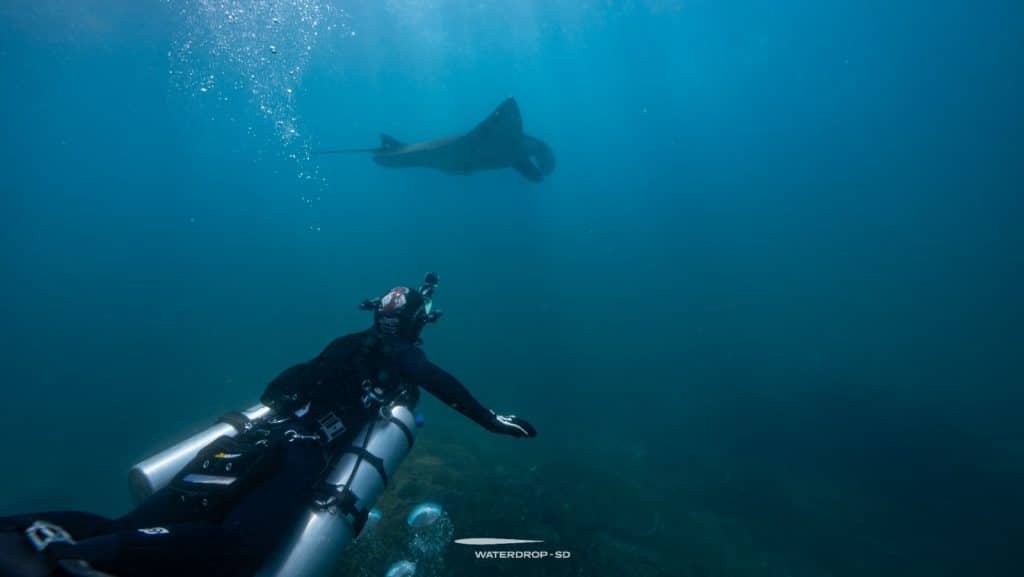
Depth: 5-30m
Difficulty: All level
You probably already guessed what you can see there. Indeed, as its name mentions, this area is the best to swim with Mantas. Other species can be spotted as well, such as bamboo and nurse sharks. Sometimes you might also see dolphins swimming on the surface, which makes it a great and accessible place to snorkel as well.

TOYAPAKEH BAY
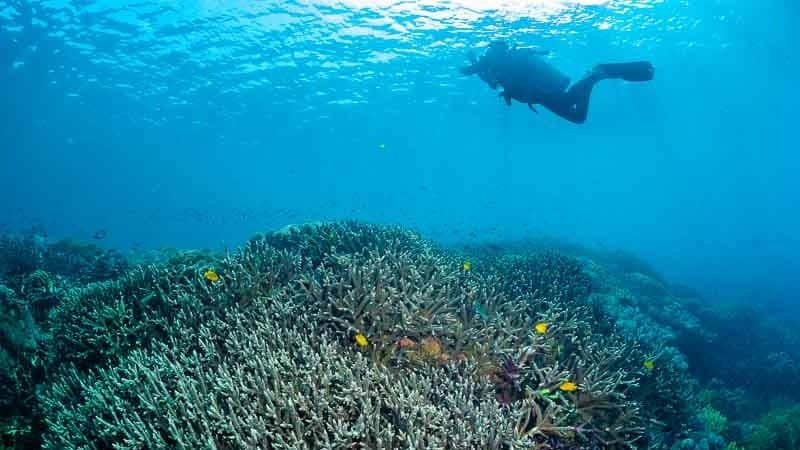
Depth: 5-40m
Difficulty: Advanced
This is a favourite of many of our dive guides for the abundance of corals and marine life as well as for the great visibility.
The dive site enjoys some shelter from the strong currents that run through the deep channel between Nusa Penida and Nusa Ceningan, usually with a gentle drift to the north. However the currents can change quickly, so stay close to our experienced local dive guides for a fun and safe dive.
The main feature of the site is the coral pillars, some of which are huge. We also find large gorgonian sea fans thriving amongst the healthy hard and soft corals and large schools of fish.
At the deeper end of the dive site we see sharks, turtles, and in season the famous Mola Mola.
BLUE CORNER
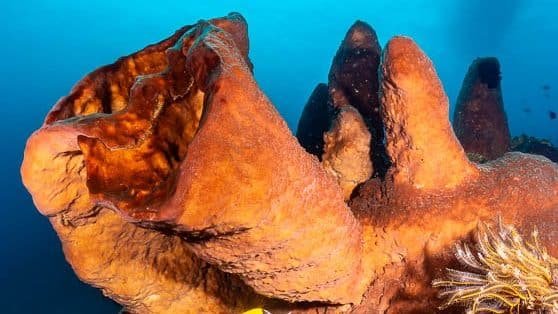
Depth: 15-30m
Difficulty: Skilled
For experienced divers only, as most of the stunning drop off on this dive site located off the shore of Nusa Lembongan is between 20 and 40 meters.
Blue Corner has a great topography and hard corals, a hugely exhilarating drift over multiple terraces full of marine life including eagle rays, marble rays and (in season) the famous sunfish. Blue Corner will be one of your favourite dives when conditions allow, although please be aware it is not always diveable due to strong currents.
The site is characterised by the strong currents that make this a very exciting dive and the water colour here has to be the deepest blue that one might have seen, so this site is aptly named ‘Blue Corner’
MANGROVE
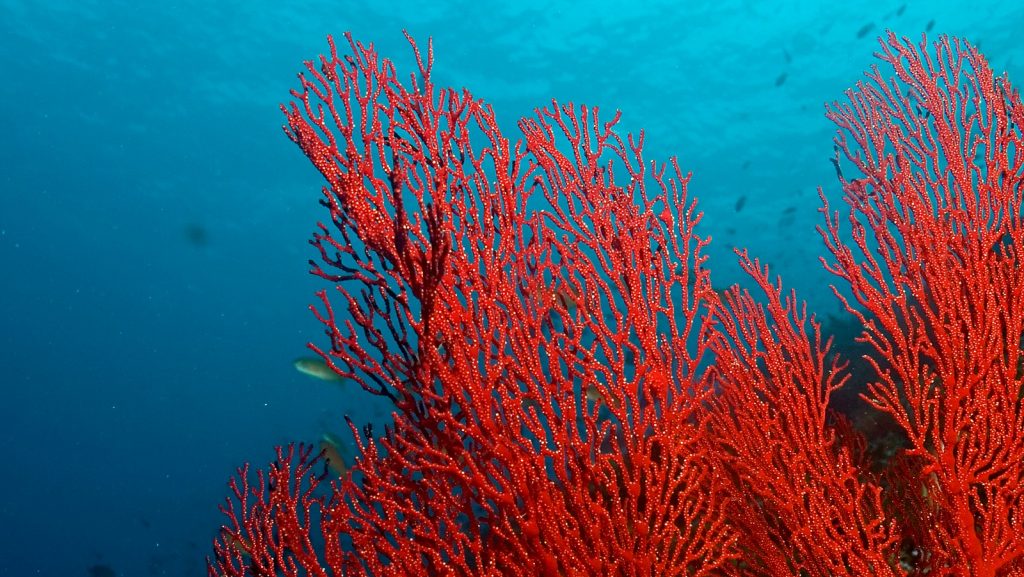
Depth: 5-30m
Difficulty: All level
Anyone diving in the Mangroves may see firsthand how essential mangroves are to the local ecosystem. It does, in fact, contribute to the reef’s health as well as the underwater scenery and corals’ quality.
Mangrove dive sites are well-known for snorkeling, but their topography makes them ideal for scuba diving. The mild slope allows for a descent to roughly 40 meters, however inexperienced divers should practice in shallower places first. Many fish, little and large, reef and pelagic, can be found on the plateau. You’ll be unsure where to look because the display is so thick. It’s truly a visual feast!
Depending on the tide and the full moon cycle, the current is moderate to mild. If it’s a windy day, maintain neutral buoyancy, face the bottom, and enjoy the show!
GAMAT BAY
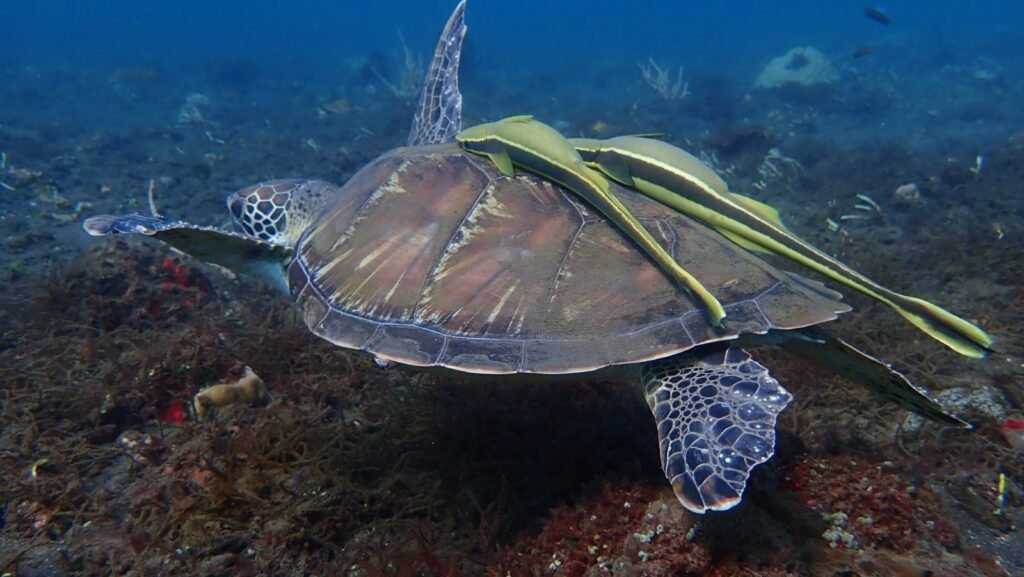
Depth: 6-40m
Difficulty: Intermediate
Looking like a giant aquarium this place offers you bright and colorful seascapes. Gamat Bay is a vast and shallow coral plateau between two rocky points. A descending slope extends the length. This plateau is 6 to 8 meters deep (a little deeper at high tide). At the further end of the bay, there is a 40-meter-long wall. Our playground is defined by a sandbank that runs in the direction of the blue. Everyone diving Gamat Bay should take advantage of this incredible playground! As a result, it’s one of our top 20 dive locations in Bali!
Drifting around the reef is the goal here. The site’s terrain, which is distinguished by beautiful coral formations, adds to the dive’s appeal and beauty. Although challenging at times, its privileged location provides an experience rich in underwater flora and fauna, from the smallest to the largest. We frequently saw nudibranchs, turtles, moray eels, batrish and marble ray squads, as well as our beloved Mola Mola.
CENINGAN wall
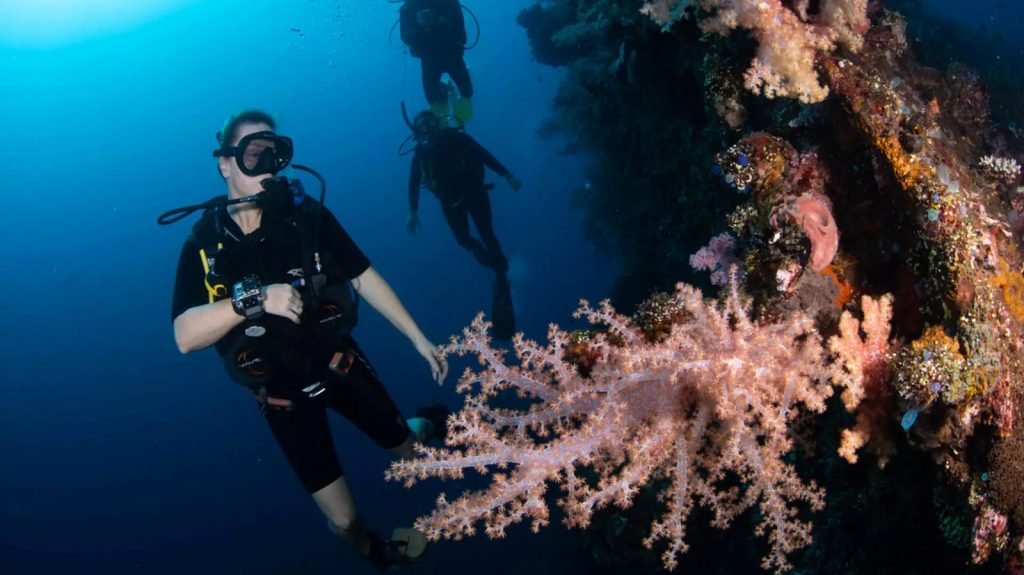
Depth: 3-30m
Difficulty: Skilled
This dive site is really a gift for dives, on a good day, it can blow your mind away!
The dive begins with a drop onto a swell-tossed shallow plateau. Surrounded by fusilier, moorish idols, and clownfish, there are already some active coral bumps. A vertiginous and multicolored wall descends further into the blue. The Ceningan Wall is a collection of species from Nusa Penida. It’s completely covered in corals, sponges, and sea fans, and it’s full of vibrant colors.
Although currents can be hard due to their geographic position, they are a huge value to the growth of fauna and vegetation. It is a well-known location for macro life. Various species of Nembrotha, Chromodoris, and Flabellina nudibranchs can be spotted. However, there are also Zanzibar shrimp and Pygmy Seahorses. Moray eels, scorpionfish, and stonefish appear to have discovered their ideal habitat while drifting along the wall.
Even if it’s difficult to take a break from staring at that hypnotic and beautiful wall, the deep blue has many surprises. There are schools of big Trevally, tuna, and batfish, as well as families of white-spotted eagle rays if you’re lucky. And, when the water grows cooler, our beloved Mola Mola!
Because to the currents, diving Ceningan necessitates concentration and rigor. Currents and thermoclines, on the other hand, are responsible for transporting all of the sediments and phytoplankton that help to form and preserve places like the Ceningan Wall. Indeed, such a rich array of hues and life has been kept here. The divers will be ecstatic.
LEMBONGAN BAY
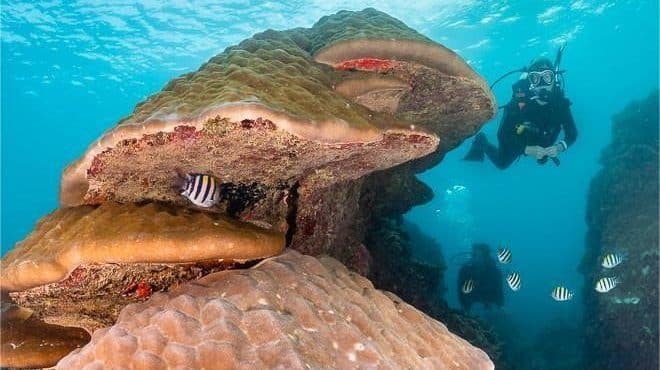
Depth: 3-15m
Difficulty: Easy
Right in front of Nusa Lembongan harbour, this bay offers calm conditions and shallow waters which makes it an ideal dive site for training and beginners. If the conditions are good and with good visibility it is an explosion of colors. In fact, the white sand bottom brings out all the colors of the large coral heads. Of course here we come for an atmospheric dive in search of juvenile fish of a thousand colors, crabs, shrimps, moray eels, octopuses, cuttlefish, anemones…
We love doing the first Open Water training dive on this site as well as the specialties like buoyancy control or fish identification.
NORTH COAST SENTAL/PED/SD/ BUYUK/TUGU
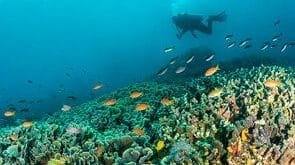
Depth: 5-40m
Difficulty: All level
Nusa Penida’s north coast, where our dive resort is located, is home to some of Bali’s most magnificent drift dives.
From SD up to Buyuk is a long strech of coast with shallow sloping reefs and some drop off covered in corals of all sorts and with amazing fish life. You can see pretty much everything here, from the smallest reef inhabitants to mola molas in season!
These dive sites, like the others mentioned above, are used for drift diving. You will, in fact, allow yourself to be dragged along the wall by the current in order to see the “movie” in front of you! Your guide will demonstrate how to use the macro in this location. Nudibranchs, crabs, and even ghost fishes are just a few examples. It is, indeed, a spectacular treasure quest that causes even expert divers to see stars in their eyes! To examine the macro, however, good buoyancy is still required! A sloppy palm stroke can keep you from seeing what your mentor is showing you. You’ll also have to wait because the first anemone does not include any ghost fish or other unusual species!
During dives, the currents may change direction, but this is not an issue because we will be going back and forth. Downdrafts can occur under unusual settings. We shall be extremely cautious when advising in these situations.
EAST COAST
SAMPALAN
KARANG SARI
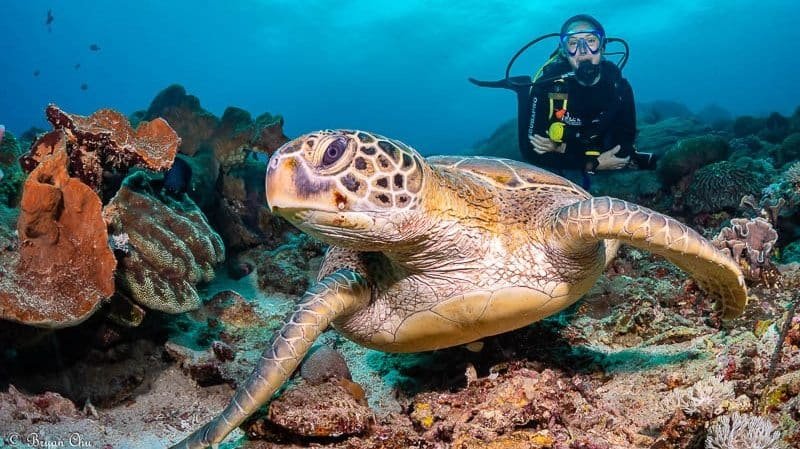
Depth: 5-40m
Difficulty: All level
These dive sites on the East coast of Nusa Penida are less visited, so it is the perfect spot to enjoy the reefs without being disturbed by the crowds!
Both offer sloping reefs and some steeper areas. The sponge covered reefs usually have milder currents allowing us to search for the abundant macro life that these sites offer. The deep waters along the reefs sometimes bring up the big stuff, sharks and mola molas are not uncommon on these sites. Molas are seen often on this side of the island so you should always keep an eye on the blue.
PADANG BAI
GILI MIMPANG
GILI TEPEKONG
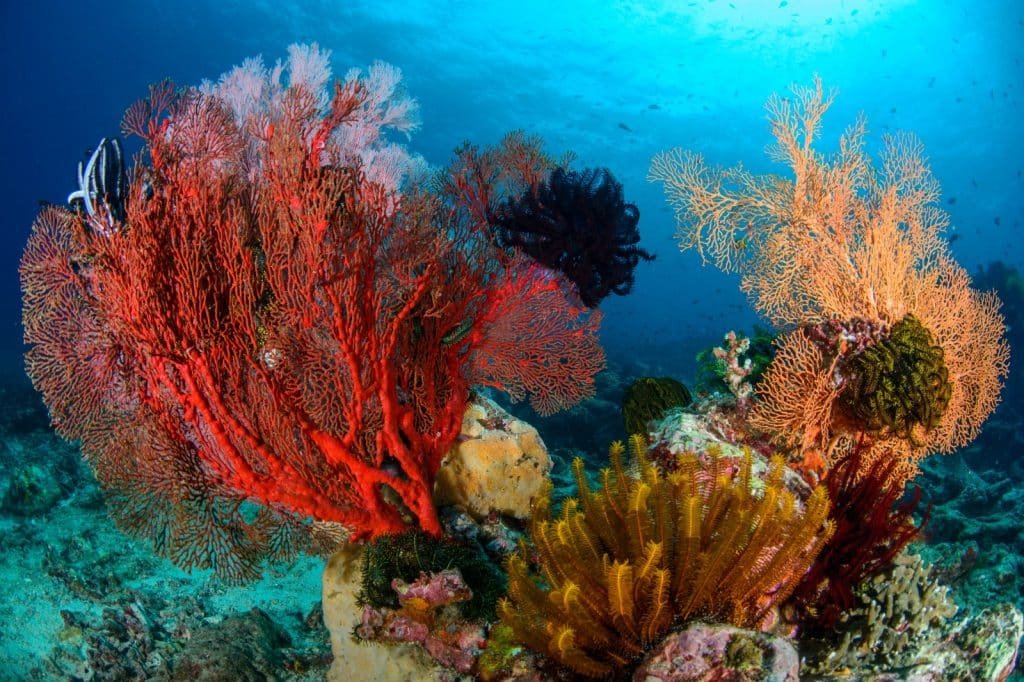
Depth: 5-40m
Difficulty: Advanced
Going from Penida to the these dive sites at Padang Bai takes the same time as going to Manta Point, and these are two best dive sites in Padang Bai, they are definitely worth the trip! Both dive sites are not for beginners, since conditions can sometimes be challenging. For both, you must be advanced diver and have a fair amount of dive experience.
Gili Mimpang is made up of 3 small groups of islets and we start the dive north of the middle one. The strong southerly current will bring us to the South where we will turn into a sheltered area. Along the way we are looking into the blue to see schools of fish, barracuda, tuna hunting, sharks and of course the Mola Mola. Air goes down quickly in your tank at Gili Mimpang. When air allows we will continue around the islet with beautiful corals and abundant marine life. Otherwise, we may be drifting in open water during our safety stop!
Gili Tepekong is one of Bali's most challenging dive sites. It is imperative to have good guides because we do not do it in the same way depending on the conditions. For experienced divers, this is one of our most popular sites where we often see sharks and mola mola! When the conditions allow it, the dive site is one of the most playful in Bali. A drop off, swim-through, play of colors in the shallow parts, a strong surge and current -this site has it all! Tepekong is a dive site for the Mola Mola in season but the topography is so nice that we never get bored of doing it all year long. With a wall, caves, and a canyon, regardless of conditions, there is always something exciting to see. Our experienced captains and guides will ensure a good dive while keeping safety a top priority -here we don't mess with Mother Nature!
